INSTITUT SUPERIEUR D'ANTHROPOLOGIE
INSTITUTE OF ANTHROPOLOGY
ONLINE COURSES / COURS A DISTANCE
DEBUT COURS : SEPTEMBRE 2023
REGISTER NOW
ESPAGNE –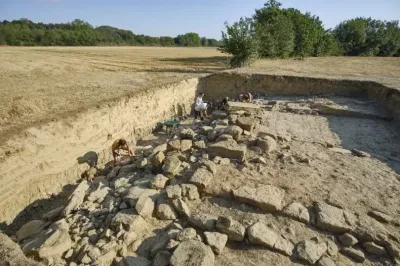
 Ullastret - The city of Ullastret is thought to date back to at least the 6th century B.C., and was first discovered in the 1930s, having been abandoned in the 2nd or 3rd century B.C. It has been excavated over the past decades, with its enormous doorway having finally been unearthed. "The latest excavations at MAC Ullastret have confirmed the existence of a monumental entrance to the lower part of the city, located in the middle of the lake of Ullastret, which was dried more than a hundred years ago. The doorway is thought to be a point of access to the lower part of the city, and had been covered in huge stone blocks. The huge entrance was found to be comprised of two parallel arms, each measuring 7.4 feet across. The arms are "built with large blocks of very well-worked stone, arranged perpendicularly to the section of wall that closes the enclosure on the western side of the settlement," a translated statement from the Museum of Archeology of Catalonia said. These walls hemmed a corridor 13 feet across that acted as the start of one of the main streets of the city.The Iberian city was built by the Indigete tribe, and is the largest urban area of its era discovered in Catalonia. Ullastret actually encompasses two settlements across the hills of Puig de Sant Andreu and Illa d'en Reixac, with this gateway being found at the northwest section of l'Illa d'en Reixac. Remains previously found within the city include remnants of houses, grain silos and temples. At its peak, the city is thought to have housed more than 6,000 people. The gateway was found completely blocked with stone blocks. The archaeologists suggest that the reason the gate was blocked was to close the city after it had been abandoned. It is thought to have been left at the end of the third century or the beginning of the second century B.C., possibly because of the second Punic war in the northeast of the Iberian peninsula. This war lasted from 218 to 201 B.C., and was between Carthage, which ruled much of North Africa and Spain, and the Romans, who at the time were limited to Italy and the nearby islands of Sardinia and Corsica.
Ullastret - The city of Ullastret is thought to date back to at least the 6th century B.C., and was first discovered in the 1930s, having been abandoned in the 2nd or 3rd century B.C. It has been excavated over the past decades, with its enormous doorway having finally been unearthed. "The latest excavations at MAC Ullastret have confirmed the existence of a monumental entrance to the lower part of the city, located in the middle of the lake of Ullastret, which was dried more than a hundred years ago. The doorway is thought to be a point of access to the lower part of the city, and had been covered in huge stone blocks. The huge entrance was found to be comprised of two parallel arms, each measuring 7.4 feet across. The arms are "built with large blocks of very well-worked stone, arranged perpendicularly to the section of wall that closes the enclosure on the western side of the settlement," a translated statement from the Museum of Archeology of Catalonia said. These walls hemmed a corridor 13 feet across that acted as the start of one of the main streets of the city.The Iberian city was built by the Indigete tribe, and is the largest urban area of its era discovered in Catalonia. Ullastret actually encompasses two settlements across the hills of Puig de Sant Andreu and Illa d'en Reixac, with this gateway being found at the northwest section of l'Illa d'en Reixac. Remains previously found within the city include remnants of houses, grain silos and temples. At its peak, the city is thought to have housed more than 6,000 people. The gateway was found completely blocked with stone blocks. The archaeologists suggest that the reason the gate was blocked was to close the city after it had been abandoned. It is thought to have been left at the end of the third century or the beginning of the second century B.C., possibly because of the second Punic war in the northeast of the Iberian peninsula. This war lasted from 218 to 201 B.C., and was between Carthage, which ruled much of North Africa and Spain, and the Romans, who at the time were limited to Italy and the nearby islands of Sardinia and Corsica.
https://www.newsweek.com/ancient-city-gateway-found-spain-1811359
FRANCE –  Lyon - Après cinq ans de recherches, les fouilles du Clos de la Visitation (5e arrondissement) ont permis de découvrir 350 pièces d'armement militaire utilisées lors de la bataille de Lyon, le 19 février 197. Pointe de flèche, tête humaine décapitée, pièces d'armement et d'équipement militaires et autres vestiges, les fouilles archéologiques du Clos de la Visitation (Lyon 5e) ont offert une formidable découverte sur les derniers instants de la bataille de Lyon. Cette caserne aurait été installée par l'empereur Tibère dans la colonie romaine de Lugdunum (Lyon) située sur l'actuelle colline de Fourvière. Elle fut le lieu d'une des ultimes escarmouches de la bataille qui opposa les légions de l'empereur Septime Sévère et de l'usurpateur Clodius Albinus, le 19 février 197 après J.-C., aux portes de la ville. Bataille perdue par Clodius qui signifia l'abandon de la ville haute de Lyon pour l'installation de la population près du lit de la Saône. Les traces de cet ultime affrontement sont clairement perceptibles au sein de cette caserne à travers les 350 pièces d'armement et d'équipement militaires qui ont été mises au jour lors de ces fouilles. Parmi ces découvertes, on retrouve notamment des éléments de casque en bronze, de talons et fers de lance, de pilum, de glaive ou encore de deux grappins de siège. Une concentration d'armes du Ier siècle qui constitue un lot exceptionnel et très rare en Europe. Sous cet entrepôt, la trentaine d'archéologues étudiants, qui se réunit chaque été depuis cinq ans, a également retrouvé des vestiges remontant à la période gauloise qui pourraient correspondre à un système défensif (murus gallicus) mis en place au moment de la Guerre des Gaules (58 à 51-50 av. J.-C.). La présence de ce rempart démontre par ailleurs la persistance de la destination militaire de ce secteur de Lugdunum et caractérise sans doute la première enceinte protégeant la colonie fondée par Lucius Munatius Plancus en 43 av. J.- C.
Lyon - Après cinq ans de recherches, les fouilles du Clos de la Visitation (5e arrondissement) ont permis de découvrir 350 pièces d'armement militaire utilisées lors de la bataille de Lyon, le 19 février 197. Pointe de flèche, tête humaine décapitée, pièces d'armement et d'équipement militaires et autres vestiges, les fouilles archéologiques du Clos de la Visitation (Lyon 5e) ont offert une formidable découverte sur les derniers instants de la bataille de Lyon. Cette caserne aurait été installée par l'empereur Tibère dans la colonie romaine de Lugdunum (Lyon) située sur l'actuelle colline de Fourvière. Elle fut le lieu d'une des ultimes escarmouches de la bataille qui opposa les légions de l'empereur Septime Sévère et de l'usurpateur Clodius Albinus, le 19 février 197 après J.-C., aux portes de la ville. Bataille perdue par Clodius qui signifia l'abandon de la ville haute de Lyon pour l'installation de la population près du lit de la Saône. Les traces de cet ultime affrontement sont clairement perceptibles au sein de cette caserne à travers les 350 pièces d'armement et d'équipement militaires qui ont été mises au jour lors de ces fouilles. Parmi ces découvertes, on retrouve notamment des éléments de casque en bronze, de talons et fers de lance, de pilum, de glaive ou encore de deux grappins de siège. Une concentration d'armes du Ier siècle qui constitue un lot exceptionnel et très rare en Europe. Sous cet entrepôt, la trentaine d'archéologues étudiants, qui se réunit chaque été depuis cinq ans, a également retrouvé des vestiges remontant à la période gauloise qui pourraient correspondre à un système défensif (murus gallicus) mis en place au moment de la Guerre des Gaules (58 à 51-50 av. J.-C.). La présence de ce rempart démontre par ailleurs la persistance de la destination militaire de ce secteur de Lugdunum et caractérise sans doute la première enceinte protégeant la colonie fondée par Lucius Munatius Plancus en 43 av. J.- C.
https://www.lefigaro.fr/lyon/lyon-des-fouilles-archeologiques-levent-un-peu-plus-le-voile-sur-la-fin-de-lugdunum-20230704
IRLANDE du NORD –  Kilmocholmóg - The team behind an archaeological dig near Lurgan, County Armagh, believe they have discovered a "higher status site". They have uncovered evidence of metal and glass working including the production of gold and silver ingots. This is the second year of excavations at the site, known as Kilmocholmóg (Church of my little Colman). Last year's week-long exploratory dig found evidence of a medieval settlement.
Kilmocholmóg - The team behind an archaeological dig near Lurgan, County Armagh, believe they have discovered a "higher status site". They have uncovered evidence of metal and glass working including the production of gold and silver ingots. This is the second year of excavations at the site, known as Kilmocholmóg (Church of my little Colman). Last year's week-long exploratory dig found evidence of a medieval settlement.
https://www.bbc.com/news/uk-northern-ireland-66122863
ROUMANIE –  Cheia - Valentina Voinea of Romania’s National Museum of History and Archaeology and Bartłomiej Szymon Szmoniewski of the Polish Academy of Sciences led a team of researchers who examined two second-century graves found in a heavily plowed burial mound in Cheia, southeastern Romania. The first grave consisted of human remains thought to have been placed in a wooden box with possessions owned by the dead person and then burned in a pit. This grave had been looted in antiquity. When the robbers left, they closed up their hole, covered it with stones, and placed a wolf skull on top of them to prevent the spirit of the deceased from exiting the grave and taking revenge, Szmoniewski suggested. The second grave held the skeletal remains of a person thought to have been buried in a wooden coffin with a glass vessel containing fragrance. A bronze coin minted between A.D. 125 and 127 during the reign of the Roman Emperor Hadrian was found in the skeleton’s mouth. The coin was likely intended to be used as payment to Charon to transport the soul of the deceased across the River Styx in Hades, Szmoniewski said. He thinks the dead people may have been Romans who had traveled to the area, while the looters may have been local Dacians.
Cheia - Valentina Voinea of Romania’s National Museum of History and Archaeology and Bartłomiej Szymon Szmoniewski of the Polish Academy of Sciences led a team of researchers who examined two second-century graves found in a heavily plowed burial mound in Cheia, southeastern Romania. The first grave consisted of human remains thought to have been placed in a wooden box with possessions owned by the dead person and then burned in a pit. This grave had been looted in antiquity. When the robbers left, they closed up their hole, covered it with stones, and placed a wolf skull on top of them to prevent the spirit of the deceased from exiting the grave and taking revenge, Szmoniewski suggested. The second grave held the skeletal remains of a person thought to have been buried in a wooden coffin with a glass vessel containing fragrance. A bronze coin minted between A.D. 125 and 127 during the reign of the Roman Emperor Hadrian was found in the skeleton’s mouth. The coin was likely intended to be used as payment to Charon to transport the soul of the deceased across the River Styx in Hades, Szmoniewski said. He thinks the dead people may have been Romans who had traveled to the area, while the looters may have been local Dacians.
https://universul.net/burial-mound-in-southeast-romania-believed-to-hold-roman-graves/
ITALIE – 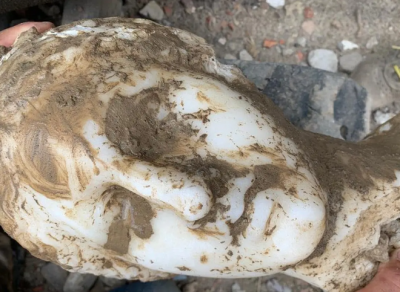 Rome - Archaeologists excavating in the Piazza Augusto Imperatore have found a marble head depicting a woman from the Roman period. The head has female features clearly defined with details such as waves of hair, lips, nose and eyes still preserved.
Rome - Archaeologists excavating in the Piazza Augusto Imperatore have found a marble head depicting a woman from the Roman period. The head has female features clearly defined with details such as waves of hair, lips, nose and eyes still preserved.
https://www.heritagedaily.com/2023/07/ornate-marble-head-found-in-romes-piazza-augusto-imperatore/147968
AUTRICHE – 
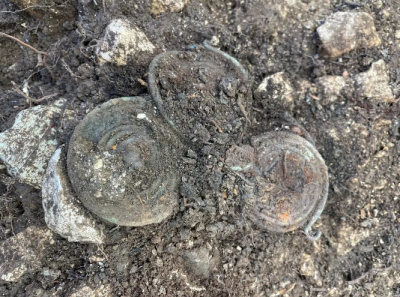 Hallstatt - Hallstatt is known for its production of salt dating back to prehistoric times, and gave its name to the Hallstatt culture, a people that emerged during the Late Bronze. Material from Hallstatt has been classified into four periods, designated “Hallstatt A” to “D”. Hallstatt A and B are regarded as Late Bronze Age, while C and D relate to the Iron Age. Recent excavations have found a burial pit containing a cremation grave and well-preserved bronze objects. Finds include a ribbed arm ring, spirals of thin wire (possibly from a fibula brooch), a bronze blade with traces of the wooden handle, and a piece of iron lead that has been identified as a belt fitting. All the artefacts were found intentionally broken or bent and placed alongside the remains of animal bones and food residue. According to the researchers, the intentional damage of metalwork was a ritual offering and may have been an expression of the death of the buried individual. Several spiral discs were also discovered, where upon closer examination the team have found traces of preserved fabric. The researchers suggest that the burial was placed in a textile bag and the spiral discs deposited on top, revealing for the first time a new distinct burial practice of the Hallstatt culture from the Iron Age.
Hallstatt - Hallstatt is known for its production of salt dating back to prehistoric times, and gave its name to the Hallstatt culture, a people that emerged during the Late Bronze. Material from Hallstatt has been classified into four periods, designated “Hallstatt A” to “D”. Hallstatt A and B are regarded as Late Bronze Age, while C and D relate to the Iron Age. Recent excavations have found a burial pit containing a cremation grave and well-preserved bronze objects. Finds include a ribbed arm ring, spirals of thin wire (possibly from a fibula brooch), a bronze blade with traces of the wooden handle, and a piece of iron lead that has been identified as a belt fitting. All the artefacts were found intentionally broken or bent and placed alongside the remains of animal bones and food residue. According to the researchers, the intentional damage of metalwork was a ritual offering and may have been an expression of the death of the buried individual. Several spiral discs were also discovered, where upon closer examination the team have found traces of preserved fabric. The researchers suggest that the burial was placed in a textile bag and the spiral discs deposited on top, revealing for the first time a new distinct burial practice of the Hallstatt culture from the Iron Age.
https://www.heritagedaily.com/2023/07/high-status-iron-age-burial-found-in-hallstatt/147954
CHINE – Laozhuangshi - A cluster of 22 ancient tombs spanning nearly 1,600 years have recently been found in Central China's Henan province. Specifically, two tombs dating back to the Eastern Han Dynasty (25-220), 12 built in the Song Dynasty (960-1279) and eight others from the Ming (1368-1644) and Qing (1644-1911) dynasties were discovered on a hill in Laozhuangshi Village of Weishi County in Kaifeng city, the then-capital city during the Northern Song Dynasty (960-1127). The Song tombs, mainly made of brick-chamber structures with stairways, are believed to belong to a family. Archaeologists have found delicate decorations inside, as the chamber walls were adorned with colorful murals themed on flowers, birds, mythical creatures, furniture, weapons and more. Doors and windows crafted in imitation wood structures were also discovered inside the chambers. "Among the discoveries were chairs, tables with tableware as well as wine or teapots placed atop, alongside other items such as scissors, flat irons, clothes racks and wardrobes," said Chang Hongjie, who works with the provincial cultural relics and archaeology institute. Chang added that the interior setting vividly provides a glimpse into the daily life of the tomb owners, offering valuable insights into the social life and burial customs during the Song Dynasty. The interior decoration and exterior design of the tomb chambers replicate the residential houses and yards in reality, which helps to understand the life scenarios in Kaifeng during the Song Dynasty, according to the researchers.
Laozhuangshi - A cluster of 22 ancient tombs spanning nearly 1,600 years have recently been found in Central China's Henan province. Specifically, two tombs dating back to the Eastern Han Dynasty (25-220), 12 built in the Song Dynasty (960-1279) and eight others from the Ming (1368-1644) and Qing (1644-1911) dynasties were discovered on a hill in Laozhuangshi Village of Weishi County in Kaifeng city, the then-capital city during the Northern Song Dynasty (960-1127). The Song tombs, mainly made of brick-chamber structures with stairways, are believed to belong to a family. Archaeologists have found delicate decorations inside, as the chamber walls were adorned with colorful murals themed on flowers, birds, mythical creatures, furniture, weapons and more. Doors and windows crafted in imitation wood structures were also discovered inside the chambers. "Among the discoveries were chairs, tables with tableware as well as wine or teapots placed atop, alongside other items such as scissors, flat irons, clothes racks and wardrobes," said Chang Hongjie, who works with the provincial cultural relics and archaeology institute. Chang added that the interior setting vividly provides a glimpse into the daily life of the tomb owners, offering valuable insights into the social life and burial customs during the Song Dynasty. The interior decoration and exterior design of the tomb chambers replicate the residential houses and yards in reality, which helps to understand the life scenarios in Kaifeng during the Song Dynasty, according to the researchers.
https://www.chinadaily.com.cn/a/202307/02/WS64a0d905a310bf8a75d6cb93.html
ANGLETERRE – 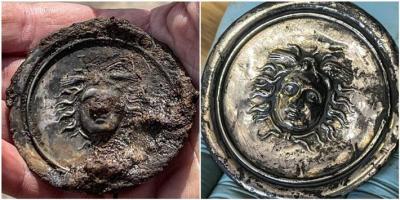 Vindolanda - A silver military decoration, or phalera, adorned with the head of the gorgon Medusa has been discovered on a barrack floor at the site of Vindolanda, a Roman fort situated on what was once the frontier of the Roman Empire in northern England. Made of precious metals, a phalera like this one would have been awarded for valor in battle and worn during parades. In Greek mythology, snake-haired Medusa could turn people to stone at a glance. In Roman culture, Medusa’s likeness was believed to repel evil, and has been found on tombs, mosaics, and battle armor. This Medusa, thought to have been lost by a soldier, is also shown with wings on her head, and may have had the ability to fly.
Vindolanda - A silver military decoration, or phalera, adorned with the head of the gorgon Medusa has been discovered on a barrack floor at the site of Vindolanda, a Roman fort situated on what was once the frontier of the Roman Empire in northern England. Made of precious metals, a phalera like this one would have been awarded for valor in battle and worn during parades. In Greek mythology, snake-haired Medusa could turn people to stone at a glance. In Roman culture, Medusa’s likeness was believed to repel evil, and has been found on tombs, mosaics, and battle armor. This Medusa, thought to have been lost by a soldier, is also shown with wings on her head, and may have had the ability to fly.
https://www.livescience.com/archaeology/romans/silver-medal-featuring-winged-medusa-discovered-at-roman-fort-near-hadrians-wall
NORVEGE – 
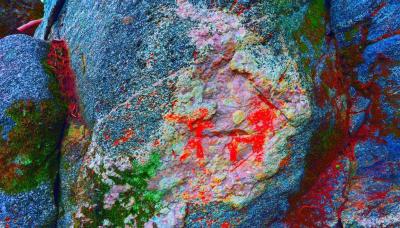 Oslo - A man on a hike with his family in the countryside outside of Oslo, Norway, has stumbled across a rock face covered in Bronze Age paintings. When Fjeld spotted a nearby boulder with unusual coloration while taking a break from hiking, he was ready. Fjeld pulled out his phone, took a picture, and then plugged it into an app that could clarify if the markings were natural pigments, such as iron deposits, or something altogether more interesting. Once a scene of human figures and animals came into view, he promptly called Jone Kile-Vesik, the local archaeologist, with whom Fjeld has collaborated many times previously.The paintings, which include depictions of rowers and standing human figures, are the first to have been found in the coastal area of Østfold and Viken—though the precise location is, for now, being kept a secret to protect them, given contact can quite easily remove pigment. It’s the first time that this type of painting has been found in southern Norway and based on the motifs and style researchers believe they were made during the Bronze Age, though the Iron Age remains a possibility. The researcher also noted that the paintings had been protected by the rock’s overhang, which means it’s possible that the whole rock was at one time covering in markings.
Oslo - A man on a hike with his family in the countryside outside of Oslo, Norway, has stumbled across a rock face covered in Bronze Age paintings. When Fjeld spotted a nearby boulder with unusual coloration while taking a break from hiking, he was ready. Fjeld pulled out his phone, took a picture, and then plugged it into an app that could clarify if the markings were natural pigments, such as iron deposits, or something altogether more interesting. Once a scene of human figures and animals came into view, he promptly called Jone Kile-Vesik, the local archaeologist, with whom Fjeld has collaborated many times previously.The paintings, which include depictions of rowers and standing human figures, are the first to have been found in the coastal area of Østfold and Viken—though the precise location is, for now, being kept a secret to protect them, given contact can quite easily remove pigment. It’s the first time that this type of painting has been found in southern Norway and based on the motifs and style researchers believe they were made during the Bronze Age, though the Iron Age remains a possibility. The researcher also noted that the paintings had been protected by the rock’s overhang, which means it’s possible that the whole rock was at one time covering in markings.
https://news.artnet.com/art-world/norway-dad-hiking-bronze-age-rock-paintings-2325758
ROUMANIE –  Alba Iulia - Apulum est un ancien fort romain situé dans ce qui est aujourd’hui la ville d’Alba Iulia, en Roumanie. Construit au IIe siècle de notre ère, il faisait partie du système défensif romain le long du Danube. Occupé par la légion romaine XIII Gemina, il servait principalement de point d’appui militaire et de centre administratif pour la région environnante. Au fil du temps, Apulum est devenu une colonie romaine prospère qui possédait des bâtiments civils, des temples, des thermes et des habitations. Récemment, les vestiges de ce fort, toujours visibles, ont fait l’objet de nouvelles fouilles. Au cours de ces recherches, menées sur une superficie de plus de 2 000 mètres carrés, des archéologues ont fait une découverte intéressante : des empreintes de chien. Toutes ont été imprimées dans les tuiles d’un luxueux bâtiment romain. D’après les chercheurs, ces chiens vivaient très probablement près d’un atelier de tuiles qui produisait des matériaux de toiture pour les maisons locales. En courant dans la cour de l’atelier, ils ont alors peut-être marché dans de l’argile encore molle, laissant leurs empreintes de pattes à la surface. La présence de ces empreintes est amusante, mais elle n’est en soi pas vraiment surprenante. Nous savons en effet que les chiens étaient des animaux de compagnie populaires dans le monde romain antique, comme en témoignent les figures canines souvent représentées dans les peintures et les poteries de cette période.Comme nous autres aujourd’hui, les Romains les considéraient d’ailleurs souvent comme des membres de la famille. Ces animaux de compagnie étaient présents dans les foyers de toutes les classes sociales, des plus modestes aux plus riches. Certains étaient aussi élevés spécifiquement pour protéger les propriétés. Nous savons par ailleurs que les Romains étaient attentifs à la santé et au bien-être de leurs chiens. Ils les nourrissaient avec des aliments spéciaux, les emmenaient en balade et les soignaient en cas de maladie. Certains étaient même enterrés avec des honneurs.Pour en revenir à ces empreintes, les archéologues notent qu’elles sont assez grandes. Elles ont donc vraisemblablement été faites par des chiens de grande race. Il est évidemment impossible de déterminer la race impliquée, mais nous savons que le Laconien et le Molossien étaient deux races de chiens de chasse populaires dans la Rome antique et la Grèce. Le Laconien était une race originaire de la région de Lacédémone, dans la Grèce antique. Ces chiens très prisés par les chasseurs et les aristocrates étaient réputés pour leur endurance, leur agilité et leur habileté à traquer le gros gibier. Le Molossien était quant à lui originaire de la région de l’Épire. Robustes et puissants, ces chiens étaient aussi utilisés pour la chasse au gros gibier, mais également pour la garde et même comme chiens de guerre.
Alba Iulia - Apulum est un ancien fort romain situé dans ce qui est aujourd’hui la ville d’Alba Iulia, en Roumanie. Construit au IIe siècle de notre ère, il faisait partie du système défensif romain le long du Danube. Occupé par la légion romaine XIII Gemina, il servait principalement de point d’appui militaire et de centre administratif pour la région environnante. Au fil du temps, Apulum est devenu une colonie romaine prospère qui possédait des bâtiments civils, des temples, des thermes et des habitations. Récemment, les vestiges de ce fort, toujours visibles, ont fait l’objet de nouvelles fouilles. Au cours de ces recherches, menées sur une superficie de plus de 2 000 mètres carrés, des archéologues ont fait une découverte intéressante : des empreintes de chien. Toutes ont été imprimées dans les tuiles d’un luxueux bâtiment romain. D’après les chercheurs, ces chiens vivaient très probablement près d’un atelier de tuiles qui produisait des matériaux de toiture pour les maisons locales. En courant dans la cour de l’atelier, ils ont alors peut-être marché dans de l’argile encore molle, laissant leurs empreintes de pattes à la surface. La présence de ces empreintes est amusante, mais elle n’est en soi pas vraiment surprenante. Nous savons en effet que les chiens étaient des animaux de compagnie populaires dans le monde romain antique, comme en témoignent les figures canines souvent représentées dans les peintures et les poteries de cette période.Comme nous autres aujourd’hui, les Romains les considéraient d’ailleurs souvent comme des membres de la famille. Ces animaux de compagnie étaient présents dans les foyers de toutes les classes sociales, des plus modestes aux plus riches. Certains étaient aussi élevés spécifiquement pour protéger les propriétés. Nous savons par ailleurs que les Romains étaient attentifs à la santé et au bien-être de leurs chiens. Ils les nourrissaient avec des aliments spéciaux, les emmenaient en balade et les soignaient en cas de maladie. Certains étaient même enterrés avec des honneurs.Pour en revenir à ces empreintes, les archéologues notent qu’elles sont assez grandes. Elles ont donc vraisemblablement été faites par des chiens de grande race. Il est évidemment impossible de déterminer la race impliquée, mais nous savons que le Laconien et le Molossien étaient deux races de chiens de chasse populaires dans la Rome antique et la Grèce. Le Laconien était une race originaire de la région de Lacédémone, dans la Grèce antique. Ces chiens très prisés par les chasseurs et les aristocrates étaient réputés pour leur endurance, leur agilité et leur habileté à traquer le gros gibier. Le Molossien était quant à lui originaire de la région de l’Épire. Robustes et puissants, ces chiens étaient aussi utilisés pour la chasse au gros gibier, mais également pour la garde et même comme chiens de guerre.
https://sciencepost.fr/anciennes-empreintes-de-chien-fort-romain/
ANGLETERRE – 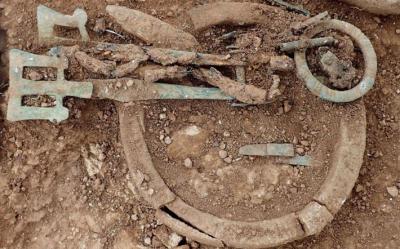 Scremby, - Analysis of an ivory ring recovered from the grave of a wealthy Anglo-Saxon woman indicates that it likely came from the tusk of an African elephant, according to a Live Science report. Hundreds of such rings, which measure between about four to six inches in diameter, have been found in Anglo-Saxon burials in England, and in a few other places in northwestern Europe. The rings are thought to have held bags that were tied to the waist and functioned as pockets. “We often find [the bags] contained objects, and they tend to be quite random,” said Hugh Willmott of the University of Sheffield. “Broken copper, Roman coins, things like that,” he explained. Strontium isotope analysis of this fifth-century ring suggests that the elephant grew up in an area with geologically young volcanic rocks, like the Rift Valley region of East Africa. The ring is therefore thought to have been crafted in East Africa at the ivory working center of Aksum, and then traded for some 4,000 miles until it reached England, where no ivory working centers have been found. Willmott said that ivory rings appear to have fallen out of use by about the seventh century, perhaps because the trade route had been disturbed.
Scremby, - Analysis of an ivory ring recovered from the grave of a wealthy Anglo-Saxon woman indicates that it likely came from the tusk of an African elephant, according to a Live Science report. Hundreds of such rings, which measure between about four to six inches in diameter, have been found in Anglo-Saxon burials in England, and in a few other places in northwestern Europe. The rings are thought to have held bags that were tied to the waist and functioned as pockets. “We often find [the bags] contained objects, and they tend to be quite random,” said Hugh Willmott of the University of Sheffield. “Broken copper, Roman coins, things like that,” he explained. Strontium isotope analysis of this fifth-century ring suggests that the elephant grew up in an area with geologically young volcanic rocks, like the Rift Valley region of East Africa. The ring is therefore thought to have been crafted in East Africa at the ivory working center of Aksum, and then traded for some 4,000 miles until it reached England, where no ivory working centers have been found. Willmott said that ivory rings appear to have fallen out of use by about the seventh century, perhaps because the trade route had been disturbed.
https://www.archaeology.org/news/11570-230703-england-ivory-ring